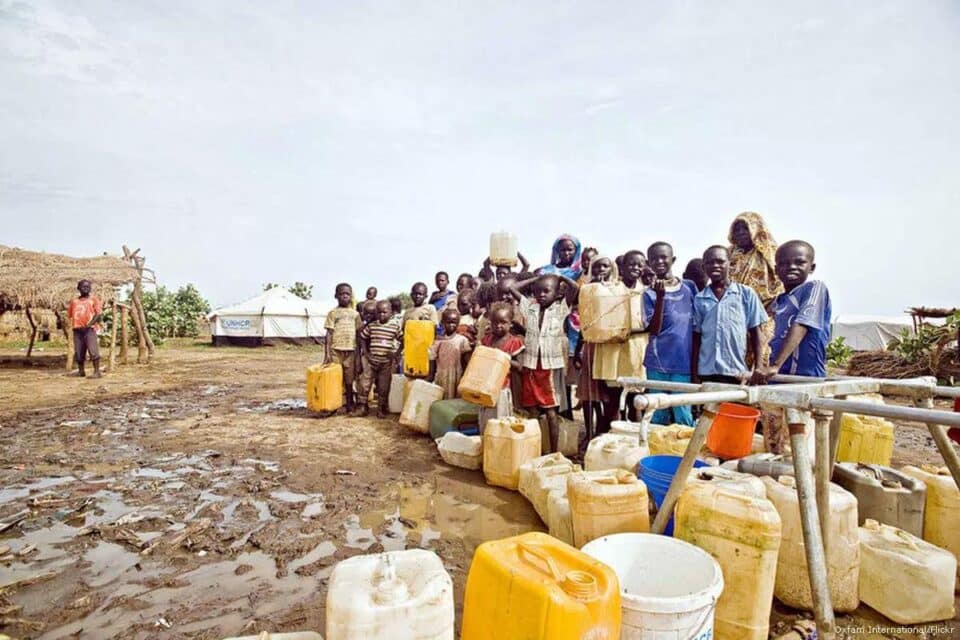Help our local partners realise their vision of hope for their communities

This essay, by Manon Powrie, received 3rd prize in the 2016 HART Prize for Human Rights, Junior Essay Category.
In South Sudan six million people do not have the basic human right to food. Not only this, but nearly three million people are facing severe levels of food insecurity. The right to food itself considers the issue of food availability; meaning food needs to be available in a quantity and quality sufficient to satisfy the dietary needs of individuals. Some of this is due to basic issues of geography; but we also need to consider how political instability and conflict have exacerbated an already fragile geographical situation.
South Sudan is located in North-Eastern Africa, whose tropical climate alternates between a rainy season and a dry season. These seasonal changes cause fluctuations in agricultural produce, as production is naturally lower in dry seasons. However, a severe drought occurred in 2011, lasting over a year and so interrupting two rainy seasons, impacting South Sudan severely, and leading to widespread crop failure. In turn, there were low levels of agricultural production. For example, during the 2011 drought net food production decreased from 695,000 tons the previous year to 475,000 tons, compared to the figure of 105 million tons in the UK in 2011. In turn, this resulted in reduced access to food for the population, who suffered more than usual from natural occurrences, their basic right to food diminished.
Perhaps the bigger issue here is how food is produced and distributed in a country so vulnerable to seasonal change. There are countries, such as Israel, a major exporter of fresh produce, which succeed with little water, not only supporting their own population, but also exporting foodstuffs. A country with relatively inhospitable geographies can support its population if agriculture is well organised. The Israeli government invests in its agriculture, ensuring a healthy export trade, and an efficient infrastructure for food distribution internally.
Therefore, one of the key issues in South Sudan is that the agricultural system is inefficient and lacks investment. 90% of households depend on crop and livestock farming for their livelihoods; however, smallholdings dominate due to the lack of government funds for the development of the country’s agribusiness. People mostly grow subsistence crops, such as corn and beans, so when the climate fails not only do people not have enough food for themselves, but there is no surplus for internal trade. In turn, only 4% of arable land is cultivated due to the lack of investment for intensive farming; as a result there is almost no capacity for green revolution investment. Effectively, without green revolution investment, which would allow new infrastructure and technologies to improve yields and production, there is an endless cycle of food insecurity. The outputs of agriculture in South Sudan are too uncertain; investment would be too much of a risk, particularly given the political situation. South Sudan is therefore excluded from trade systems, as it cannot compete against other countries; people lack a right to food because of the lack of interest in agriculture by politicians confronted with the problem of conflict, and the humanitarian crises they lead to.
The food insecurity issue and the lack of the right to food is not only a geographical problem, then, but also a political problem. A land without sufficient water requires substantial investment in food technologies and distribution networks, these in turn requiring a stable social and political environment so that investors can be attracted to growing agribusiness. The World Food Programme reported that in 2006 the main constraint for crop cultivation in South Sudan was the presence of pests and crop diseases. However, the problem could be eradicated with more investment in appropriate pesticides and weed killers. Yields would increase, allowing surpluses for internal trade, rather than being locked in precarious subsistence cycles. In a virtuous cycle this would reduce the dependence on subsistence farming, and partially resolve the current widespread food insecurity. A fuller solution to the suffering of South Sudan would require rigorous application of a range of biotechnologies embedded in a recognition that these cannot function without political stability.